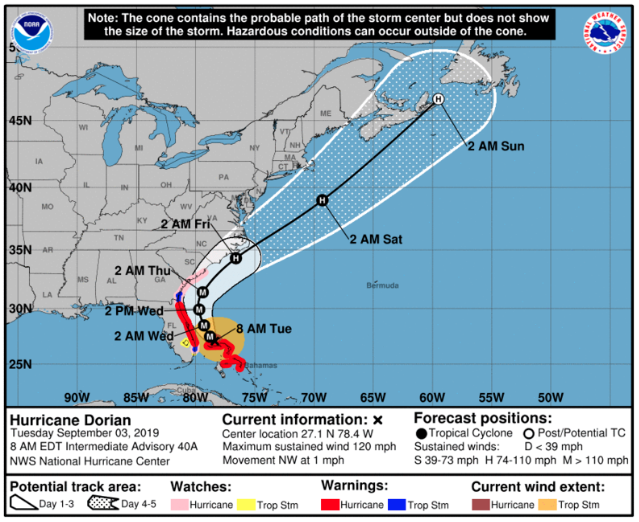Greenwich Harbormaster Ian MacMillan said with communities along the South East coast are bracing for Dorian, which has rapidly intensified into a Category 4 hurricane, now is as good a time as any to remind local mariners to go over their preparations.
— This article is adapted from one in GreenwichFreePress.com.
Dorian may strike with life-threatening storm surge and destructive winds are expected.
Dorian is also generating dangerous surf and rip currents, and (if it follows the general predictions for it’s path this week) a surge along the East Coast.
“The most remarkable thing about this storm is how slowly it’s moving, because that builds a bigger surge,” MacMillan said on Labor Day. “This is as good time as any for local mariners to go over their preparations.”

Image from National Weather Service
As of Tuesday morning, Dorian was a Category 3 hurricane, less intense than previously.
Hurricane Preparedness Steps
MacMillan offered the following steps to prepare vessels in the event of a storm, but said these actions should be practiced as a standard, since unnamed and unpredicted storms can also cause significant damage.
In order to best protect your boat in the event of a hurricane or other storm, the following guidelines can be followed:
Life Jackets
Don’t underestimate the value of life jackets or Personal Flotation Devices, and carry a whistle.
Remove your boat to a safe harbor if it looks bad
If at all possible, boat owners should attempt to have their boats hauled out or relocated to a sheltered harbor.
Reduce windage
Remove anything from your boat that can catch wind and may become airborne.
This can include:
● All flags or anything from rigging, e.g. radar reflectors.
● Dodgers, biminis, or other removable canvas.
● All sails including roller furling, mainsail, and boom if possible on smaller boat. Alternatively, lash down with line and additional sailties.
● All other cruising-type items in lockers or below deck (propane, fuel, anything flammable placed ashore or in ventilated lockers.) Rig a storm bridle i.e. secondary bridle tied around your mast or primary winches.
● A storm line or bridle can be attached to your bow cleat at all times. Attachment should be verified prior to a storm.
● This is rigged as a secondary bridle alongside the primary bridle. This bridle should have slack in it compared to the primary bridle and only engage if the primary fails. Use chafing gear.
Remove and stow anchors
Remove all anchors from the bow of your boat. Anchors, especially plow anchors, can act like knives in rough seas and cut mooring bridles. Any boats left unattended on moorings for extended periods of time should follow this procedure as a standard practice. Inspect chocks and cleats.
Make sure that chocks have no rough edges that can cause chafe, and make sure cleats are securely fastened to the deck. During rough seas little can be done to prevent a bridle from chafing on a burred chock.
You may use chafing gear with some liquid soap to lubricate. Leave your boat unlocked, batteries charged and on, keys in ignition.
Check your bilge and pumps. Keep a flashlight handy and your contact information.
On a dock or slip
Extra lines, extra fenders and keep the lines from being too tight. Be sure to have fenders between your boat and your neighbor’s boat as well as the dock.
It is possible to aid in the recovery of vessels, but this is greatly helped if the boat is easily boarded and gotten underway. The person helping you or your vessel in an emergency will likely be unfamiliar with your boat. It is also important to have extra fenders, dock and towing lines available in an obvious and easily accessible place.
Come early to prepare for the storm
Don’t wait until the day of a storm to prepare for the event.
Conditions may prevent launch and tender services from operating at certain times. In case of emergency or danger, the mariners nearby will do whatever is practicable to insure the safety of yachts belonging to the others, but neither they nor the professionals assume any responsibility for such yachts.
If conditions warrant, the State Harbormaster may suspend the launch, and tender services at his discretion until such conditions pass.
The launches and private tenders may not be operated at any time by other than by designated captains and in this case the Harbormaster’s decision is final.
The National Hurricane Center provides storm tracking detail.
